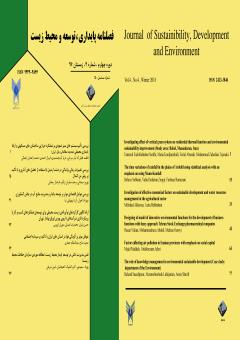Sustainable Urban Development in Relation to Measuring the Livability Level of Cities (Case Study: Lorestan Province)
Subject Areas : landuse
mohsen rezaei
1
,
ali sheikhazami
2
*
![]() ,
majid vali shariat panahi
3
,
nasrollah fallahtabar
4
,
majid vali shariat panahi
3
,
nasrollah fallahtabar
4
1 - Department of Geography, North Tehran Branch, Islamic Azad University, Tehran, Iran.
2 - Department of Geography, North Tehran Branch, Islamic Azad University, Tehran, Iran. *(Corresponding Author)
3 - Department of Geography, Yadegar Imam Khomeini Branch, Shahr Ray, Islamic Azad University, Tehran, Iran.
4 - Department of Geography, Yadegar Imam Khomeini Branch, Shahr Ray, Islamic Azad University, Tehran, Iran.
Keywords: Sustainable urban development, Urban viability, Lorestan province, Khorram Abad, Al Shatar.,
Abstract :
Background and Objective: ¬In recent decades, along with the paradigms of sustainable development and sustainable urban development, the idea of improving the quality of life which itself causes cities to be livable, has opened its place in the literature of urban planning, this research, sustainable urban development in relation to a concept called the livability level of cities, with emphasis on Lorestan province and three cities of Khorram. Abad, Elshtar, Kohdasht were discussed and analyzed. The exploratory approach of the research is limited to the research question and seeks to answer this main question: "Will the city of Khorramabad achieve the goals of sustainable development compared to the cities of Kohdasht and Elshtar in the future?" Material and Methodology: The research method in the present study is descriptive-analytical and exploratory. The technique of gathering statistics and information, using library methods, using statistical tables of the results of population and housing censuses and urban master plan, field studies are carried out. The method of collecting information is by using the library method, internet networks, direct observation, the use of statistical tables of the results of the population and housing censuses and the comprehensive urban plan and field studies (unorganized interviews and preparation of questionnaires). The statistical population includes citizens and professionals related to the research topic in the three cities of Khorram Abad, Al Shatar and Kohdasht. Findings: Data analysis has been done by using hierarchical model (AHP), TOPSIS model and geographic information system (Arc GIS) and t-test. What was concluded as the result of the research was that according to table number 1 to 17, it can be said that the level of significance obtained from the value of t statistic is less than 0.05, which shows that with a confidence level of 95%, there is a significant difference between the value and the average of the society in All cases are found in the three cities of Khorramabad, Kohdasht and Al-Shatar. On the other hand, due to the fact that the average of the studied samples in the above table is somewhat higher than the value value or the standard value (somewhat option = 3), Khorram Abad: (average difference = 0.456) Kohdasht: (average difference = 638/ 0) Al-Ashtar: (mean difference = 0.181). Discussion and Conclusion: Therefore, in answer to the main question of the research, it can be said that "the livability level of Khorramabad, Kohdasht and Al-Shatar cities has been established at a high level in order to reach the goals of sustainable development in the future based on the balanced assessment method (BSC). Finally, in order to compare these three cities, the equality of variances was checked using Lon's test, and it can be seen that the three cities of Khorram Abad, Kohdasht and Al Shatar are in different groups. Therefore, there is a difference in livability between all three cities, according to the reported values, the livability of Kohdasht city is more than Khorramabad and Al-Shatar cities.
1. Mc Nutry. R. H., C. page. Eds., 1994. state American community Washington DC: parteners of livable communities (PLC).
2. Sasanpour, F., Tawalai, S., Jafari Asadabadi, H., 2015. Measurement and evaluation of urban livability in the twenty-two districts of Tehran metropolis, Regional Planning Quarterly, Volume 5, Number 18.6.
3. Bandarabad, A., Ahamadinezhad, F, 2014. Assessment of quality of life with emphasis on the principles of habitable cities in the region 22 of Tehran. Journal of Research and Urban Planning, Vol. 5, No.16, 55-74.
4. Mohammadi, P. 2019. Investigating the status of urban livability indicators in Shahrekord based on the position of urban management. Journal of Applied Research in Geographical Sciences. 20(57): 205-222
5. Lan, F., Gong, X., Da, H., & Wen, H. 2020.How do population inflow and social infrastructure affect urban vitality? Evidence from 35 large-and medium-sized cities in China. Cities, 100, 102454.
6. Bandar Abad, A.R., 2010. Codification of principles of spatial development pattern and Iranian form of livable city, Case study: zone 1, 15 and 22 of Tehran. Ph.D. thesis of urbanism, Islamic Azad University.
7. Leby, J.L., Hashim, A.H., 2012. Livability Dimensions and Attributes: Their Relative Importance in the Eyes of Neighborhood Residents. Journal of Construction in Developing Countries, 12(1), 76–31.
8. Landry, C., 2000. Urban Vitality: A New Source of Urban Competitiveness, Prince ClausFund Journal, ARCHIS issue 'Urban Vitality / Urban Heroes.
9. Ottawa county planning commission., 2004. Ottawa county urban smart growth, planning and grants department.
10. Surface, T. P. P., 2006. From the Margins to Mainstream: A Guide to Transportation Opportunities in Your Community, Final Edition.
11. Saqabi, M., E. Mafi, M. Vatanparast, 2022, Evaluation and measurement of urban livability and affecting factors it (case study of Bojnord city), Applied Research Journal of Geographical Sciences,No 67, 335-350

